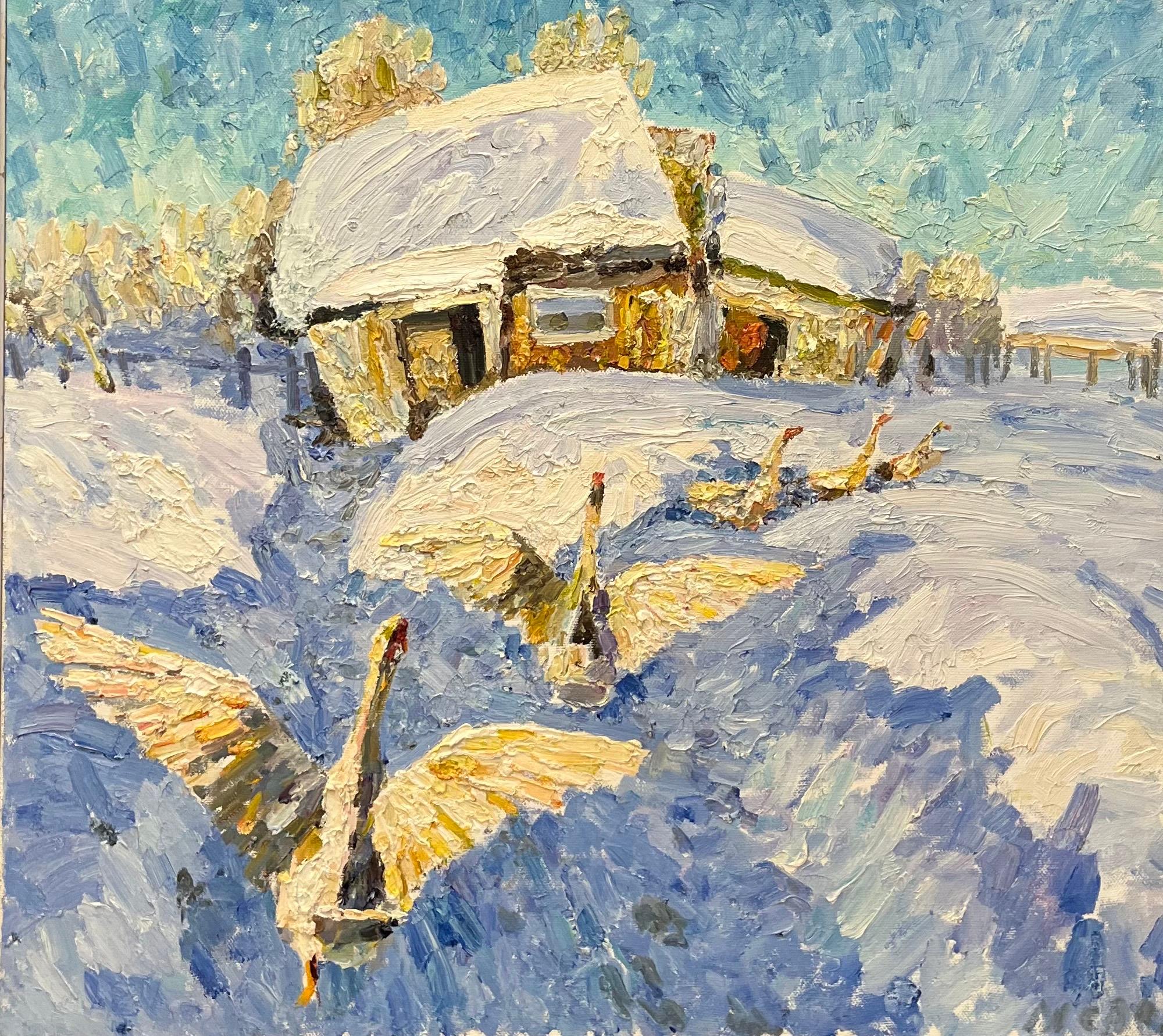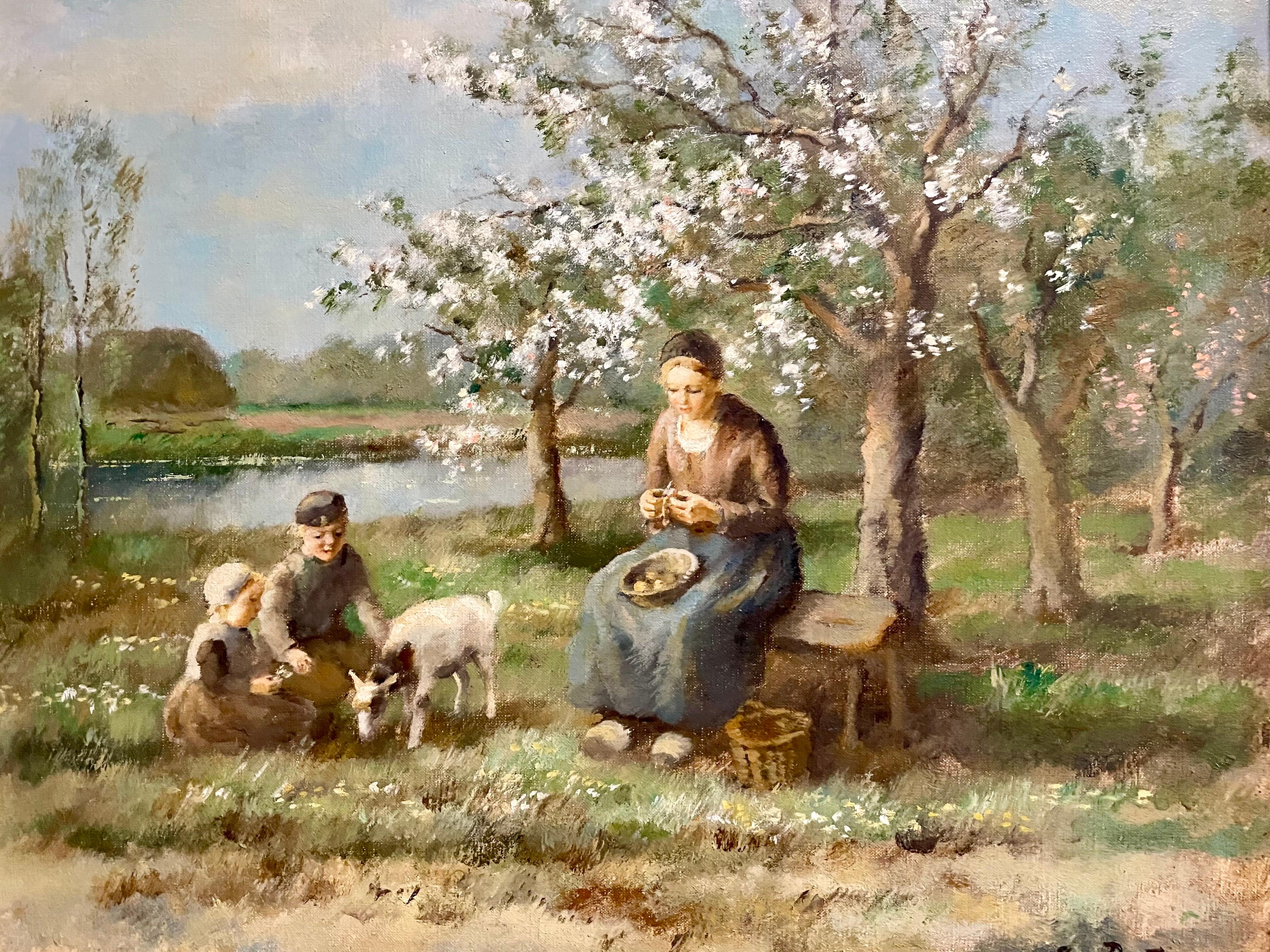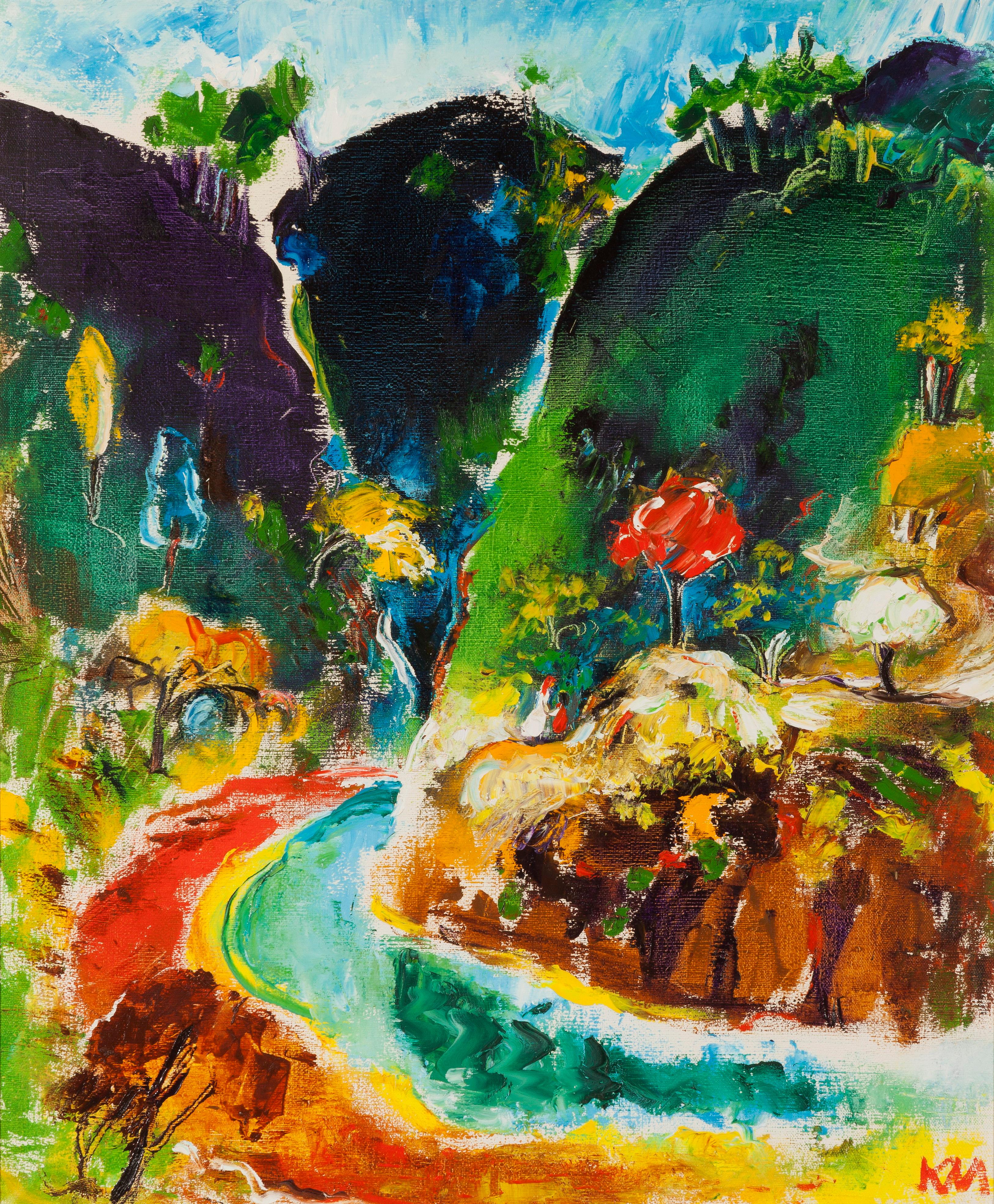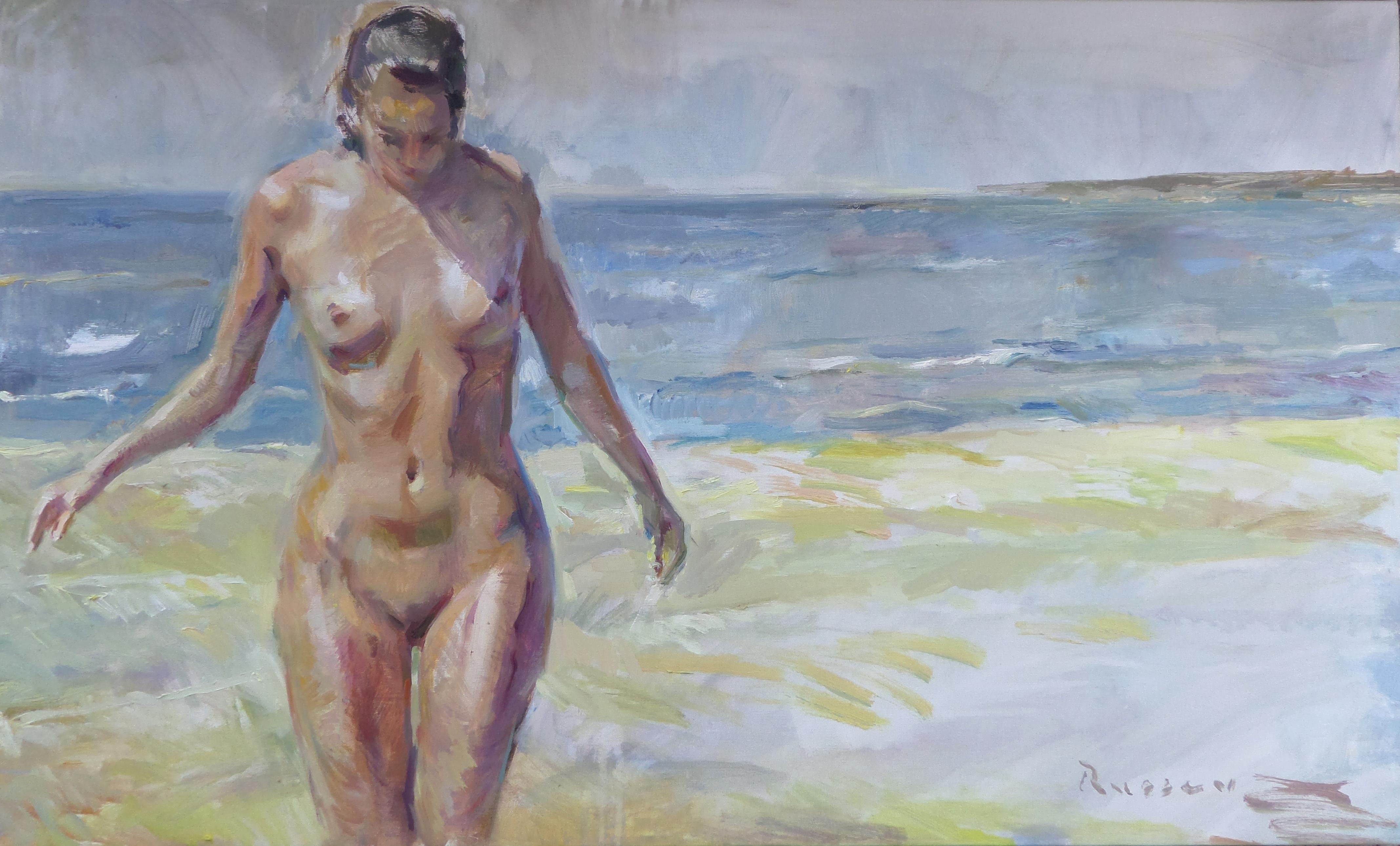Items Similar to Alfred Stevens, Brussels 1823 – 1906 Paris, Belgian, 'Clair de Lune sur la Mer'
Video Loading
Want more images or videos?
Request additional images or videos from the seller
1 of 12
Alfred StevensAlfred Stevens, Brussels 1823 – 1906 Paris, Belgian, 'Clair de Lune sur la Mer'1892
1892
About the Item
Stevens Alfred
Brussels 1823 – 1906 Paris
Belgian Painter
'Clair de Lune sur la Mer'
Signature: Signed lower right and dated 92
Medium: Oil on canvas
Dimensions: Image size 81 x 65 cm, frame size 97,50 x 81,50 cm
Provenance:
- Collection M. Klein, 1900 - Galerie Petit, Paris, 18 June 1926, nr. 22 - Private collection, Europe - De Vuyst, Belgium, 1998 - Galerie Kuppermans, Amsterdam - Private collection
- The Netherlands Exhibition - Exposition de l'oeuvre d'Alfred Stevens, Palais des Beaux Arts, Brussels, 1928
- Retrospective Alftred Stevens, Ecoile des Beaux Arts, Paris 1900, nr. 100
Literature:
- Alfred Stevens, Francois Boucger, Ed. Rieder Paris 1930, illustrated on page 36
- Documentation by Mrs Christiane Lefebre, 1998
Biography:
Alfred Émile Léopold Stevens (11 May 1823 – 24 August 1906) was a prominent Belgian painter renowned for his depictions of elegant modern women. His works, characterized by a realistic style and meticulous attention to detail, reveal the influence of 17th-century Dutch genre painting. While he initially gained attention for his social realist portrayal of the hardships faced by impoverished vagrants, he later achieved great critical and popular success with his portrayals of upper-middle class Parisian life. Notably, he often used the same models repeatedly, with some of them being identified in the infamous Book of the Courtesans, a confidential surveillance file maintained by the Paris vice squad, as noted by author Summer Brennan.
Stevens was born in Brussels, into a family deeply connected with the visual arts. His older brother Joseph (1816–1892) and his son Léopold (1866–1935) were both painters, while his other brother Arthur (1825–1899) was an art dealer and critic. His father, a veteran of the Napoleonic wars under the army of William I of the Netherlands, was an art collector with a notable collection of watercolors by Eugène Delacroix and other esteemed artists. Stevens’s upbringing was influenced by the environment of Café de l’Amitié, run by his maternal grandparents in Brussels, which served as a meeting place for prominent figures from the political, literary, and artistic spheres. Following the death of his father in 1837, Stevens left middle school to enroll at the Académie Royale des Beaux-Arts in Brussels. There, he came under the tutelage of François Navez, a Neo-Classical painter and former student of Jacques-Louis David, who was both the director of the academy and an old acquaintance of Stevens’s grandfather. Following a traditional curriculum, he initially drew from casts of classical sculptures and later transitioned to drawing from live models. In 1843, Stevens journeyed to Paris to join his already established brother, Joseph. He gained admission to the École des Beaux-Arts, the preeminent art school in Paris, although claims of him being a student of the director, Jean Auguste Dominique Ingres, are likely unfounded. One of his early works, The Pardon or Absolution (Hermitage, St. Petersburg), signed and dated 1849, showcased his mastery of a conventional naturalistic style influenced by 17th-century Dutch genre painting.
Stevens’s work was first publicly exhibited in 1851, when three of his paintings were featured at the Brussels Salon. He received a third-class medal at the Paris Salon in 1853, followed by a second-class medal at the Universal Exposition in Paris in 1855. His painting Ce qu’on appelle le vagabondage [What is called vagrancy] (Musée d’Orsay, Paris) garnered attention from Napoleon III, leading to a change in policy regarding the use of soldiers to remove the poor from the streets. Two other paintings displayed at the Salon in Antwerp in the same year, Chez soi or At Home and The Painter and his Model, introduced subjects from “la vie moderne” that became characteristic of his oeuvre: elegant young women dressed in contemporary fashion and artists in their studios. In 1857, Stevens made his first significant sale to a private collector when Consolation was purchased for a rumored 6,000 francs by the Berlin collector and dealer Ravéné. He and his brother also became part of the artistic milieu in Paris, frequenting salons hosted by Princess Mathilde and popular cafes, where they mingled with the likes of the Goncourt brothers, Théophile Gautier, and Alexandre Dumas. Stevens married Fanny Juliette Albertine Marie Hortense Blanc (1836-1891), a member of a wealthy Belgian family and a long-time acquaintance of the Stevens family, in 1858. The wedding was witnessed by the renowned painter Eugène Delacroix. The couple had four children: Leopold, Jean, Catherine, and Pierre. Stevens depicted his wife in numerous portraits, including Regrets and Memories. After her passing, he expressed enduring grief at her loss. During the 1860s, Stevens rose to considerable acclaim for his paintings of fashionable modern women.
His exhibits at the Salons in Paris and Brussels garnered favorable critical reception and attracted enthusiastic buyers. Notably, his work La Dame en Rose or Woman in Pink (Royal Museums of Fine Arts of Belgium, Brussels), completed in 1866, exemplified a blend of a stylishly attired woman in an interior setting with a detailed exploration of Japanese objects, reflecting his early enthusiasm for Japonisme. In 1863, he was awarded the Legion of Honor (Chevalier) by the French government. In 1867, he secured a first-class medal at the Universal Exposition in Paris, and his rank was elevated to Officer of the Legion of Honor. His social circle included prominent figures such as Édouard Manet, Edgar Degas, Charles Baudelaire, Berthe Morisot, James Abbott McNeill Whistler, Frédéric Bazille, and Puvis de Chavannes, and he was a regular patron of the Café Guerbois in Paris.
Stevens participated in the defense of Paris during the Franco-Prussian War but returned to Belgium with his family before the Paris Commune. They later returned to Paris, where Stevens continued to enjoy critical acclaim and success among collectors. In 1875, he purchased a grand house and garden on rue des Martyrs in Paris, which appeared in his paintings as well as those of other artists, such as Édouard Manet’s The Croquet Party. However, he was forced to vacate the property in 1880 to make way for the construction of a new street, which was eventually named after him. In 1878, he was appointed Commander of the Legion of Honor and was awarded another first-class medal at the Salon.
Despite earning a significant income from the sale of his paintings, Stevens faced financial difficulties during the 1880s due to a combination of poor investments and excessive spending. His financial strain was further compounded by the cost of summer trips to the seaside, which a doctor had advised him to take for health reasons in 1880. Consequently, when the Paris dealer Georges Petit offered him 50,000 francs to finance his vacations in exchange for paintings created during that period, Stevens agreed. This arrangement, spanning three years, resulted in the sea becoming a significant subject in his work, and over the course of his career, he produced numerous views of popular resorts along the Normandy coast and the Midi in the south. Many of these works were executed in a sketchy style influenced by the Impressionists.
Stevens also began teaching private students, including the renowned actress Sarah Bernhardt, who became a close friend, and the American artist William Merritt Chase. Other notable students included Berthe Art, Charles Bell Birch, Jules Cayron, Marie Collart-Henrotin, Louise De Hem, Harriet Campbell Foss, Georgette Meunier, Lilla Cabot Perry, Jean-Paul Sinibaldi, and Fernand Toussaint. The most significant work from the latter part of Stevens’s career was the monumental Panorama du Siècle, 1789–1889, which he painted in collaboration with Henri Gervex. In this project, Stevens painted the women and intricate details, while Gervex focused on the male figures, with the assistance of fifteen assistants. The painting garnered significant acclaim when it was exhibited at the International Exhibition in Paris in 1889.
Stevens received several notable tributes during his lifetime. In 1895, a large exhibition of his work was held in Brussels, followed by a retrospective exhibition at the Ecole des Beaux-Arts in Paris in 1900, marking the first retrospective dedicated to a living artist by the institution. Supported by patrons led by the Comtesse de Greffulhe, the exhibition achieved both social prestige and widespread acclaim. In 1905, Stevens was the only living artist featured in a retrospective exhibition of Belgian art in Brussels. Despite these accolades, he struggled to sell enough of his work to alleviate his financial difficulties. Having outlived his brothers and the majority of his friends, Stevens passed away in Paris in 1906, residing alone in modest accommodations while remaining in touch with his four children.
- Creator:Alfred Stevens (1823 - 1906)
- Creation Year:1892
- Dimensions:Height: 38.39 in (97.5 cm)Width: 32.09 in (81.5 cm)Depth: 3.94 in (10 cm)
- Medium:
- Movement & Style:
- Period:
- Condition:The artwork is elegantly displayed within a high-quality frame, impeccably preserved in its excellent condition. This piece is presented in a state suitable for immediate gallery hanging, having undergone professional cleaning and review.
- Gallery Location:Bruges, BE
- Reference Number:1stDibs: LU2006213599852
About the Seller
5.0
Vetted Seller
These experienced sellers undergo a comprehensive evaluation by our team of in-house experts.
Established in 1998
1stDibs seller since 2022
14 sales on 1stDibs
Typical response time: 1 to 2 days
- ShippingRetrieving quote...Ships From: Bruges, Belgium
- Return PolicyA return for this item may be initiated within 14 days of delivery.
More From This SellerView All
- A Little Farmhouse, Georges De Sloovere, Bruges 1873 – 1970, Belgian PainterLocated in Bruges, BEA Little Farmhouse De Sloovere Georges Bruges 1873 – 1970 Belgian Painter Bruges School Signature: Signed bottom left Dimensions: Image size 71 x 60 cm, frame size 81 x 70 cm Mediu...Category
Early 20th Century Impressionist Landscape Paintings
MaterialsCanvas, Oil
- A Pair of Swans, Leonie Arden, Antwerp 1859 – 1904 Brussels, Belgian, SignedLocated in Bruges, BEA Pair of Swans Leonie Arden Antwerp 1859 – 1904 Brussels, Belgian Painter Signature: Signed bottom right Medium: Oil on canvas Dimensions: Image size 21,5 x 27 cm, frame size 28 x...Category
19th Century Impressionist Animal Paintings
MaterialsCanvas, Oil
- A Path in the Forest, Frans Binjé, Luik 1835 – 1900 Brussels, Belgian PainterLocated in Bruges, BEA Path in the Forest Binje Frans Luik 1835 – 1900 Brussels Belgian Painter Signature: Signed bottom right Dimensions: Image size 36 x 22 cm, frame...Category
19th Century Impressionist Landscape Paintings
MaterialsCanvas, Oil
- Victor Gilsoul, Brussels 1867 – 1943, Belgian Painter, A Landscape with a MillBy Victor GilsoulLocated in Bruges, BEVictor Gilsoul Brussels 1867 – 1943 Belgian Painter A Landscape with a Mill Signature: Signed bottom right Medium: Oil on canvas Dimensions: Image size ...Category
Early 20th Century Impressionist Landscape Paintings
MaterialsCanvas, Oil
- Along the Lake, Adolphe Keller, Brussels 1880 – 1968, Belgian Painter, SignedBy Adolphe KellerLocated in Bruges, BEAlong the Lake Keller Adolphe Brussels 1880 – 1968 Belgian Painter Signature: Signed bottom right Medium: Oil on canvas Dimensions: Image size 51 x 61 cm Biography: Keller Adolphe was born on June 21 in 1880 in Brussels. He was a post-Impressionist painter of genre scenes and flower still lifes, but with a preference for landscapes. He was also draughtsman, watercolourist and pastelist. He studied at the Academies of Fine Arts in Brussels and Sint-Joost-Ten-Node with master teachers P. Braeke and H. Ottevaere. In 1910 he took part in the great Brussels Exhibition. He often paints around the Red Cloister (Auderghem) on the edge of the Sonian Forest, where he settled in 1934. He also painted in the South of France, in Saint-Tropez. Keller was a chairman of the Alfred Bastien...Category
20th Century Impressionist Landscape Paintings
MaterialsCanvas, Oil
- Georges De Sloovere, 1873 – 1970, Ruins in the Garden of Flowers, Oil paintingLocated in Bruges, BE"Ruins in the Garden of Flowers" by De Sloovere Georges Bruges, Belgium 1873 – 1970 Bruges School Signature: Signed bottom left Medium: Oil on canvas Dimensions: Image size 92 x 66...Category
Early 20th Century Impressionist Landscape Paintings
MaterialsCanvas, Oil
You May Also Like
- "Geese in the snow" oil cm. 100 x 80By Georgij MorozLocated in Torino, ITSnow, geese,white,Ukraine Georgij MOROZ (Dneprodzerzinsk, Ucraina, 1937 - St. Petersburg, 2015) 1937: he was born in Dneprodzerzinsk, Ucraina. 1949-56: he began artistic studies in ...Category
Early 2000s Impressionist Animal Paintings
MaterialsCanvas, Oil
- In the Meadow, Springtime DutchBy Cornelis BouterLocated in Hillsborough, NCSpringtime, 'In the Meadow' by Cornelis Bouter (1888-1966) is a Dutch painting with figures and landscape in an impressionist style with early spring blossoms. Idyllic scene by a river under tree blossoms, this fine oil on canvas painting is very well presented in an original frame. Children play while mother peels apples in a pleasant afternoon setting. Sure to please this Easter! Imported by Saltire...Category
Early 20th Century Impressionist Figurative Paintings
MaterialsCanvas, Oil
- Canyon - Landscape Painting Blue White Green Yellow BrownBy Krasimira MihailovaLocated in Sofia, BG"Canyon" is an impressionist painting by Maestro Krassimira Mihaylova. About the artwork: TECHNIQUE: oil painting STYLE: Impressionist, Contemporary Edition: Unique, signed Weight...Category
Early 2000s Impressionist Landscape Paintings
MaterialsOil, Canvas
- Little Green Meadow - Landscape Painting Blue White Green Yellow Brown RedBy Krasimira MihailovaLocated in Sofia, BG"Little Green Meadow" is an impressionist painting by Maestro Krassimira Mihaylova. About the artwork: TECHNIQUE: oil painting STYLE: Impressionist, Contemporary Edition: Unique, ...Category
Early 2000s Impressionist Landscape Paintings
MaterialsOil, Canvas
- Turung by Night - Landscape Painting Colors Blue Green White Brown Grey PastelBy Alina KhrapchynskaLocated in Sofia, BGDear clients, Thank you so much for your interest to the art of Maestro Alina Khrapchynska. The artist Maestro Khrapchynska has escaped the war in Ukraine and she is safe with her f...Category
2010s Impressionist Landscape Paintings
MaterialsOil, Canvas
- Summer - Nude Oil Painting Colors Blue White Grey Green Pale Brown YellowBy Ivan RoussevLocated in Sofia, BG"Summer" is a painting by the impressionist Ivan Roussev. About the artwork: TECHNIQUE: oil painting STYLE: Impressionist, Contemporary Edition : Unique, signed Weight: Approximate...Category
2010s Impressionist Landscape Paintings
MaterialsOil, Canvas





